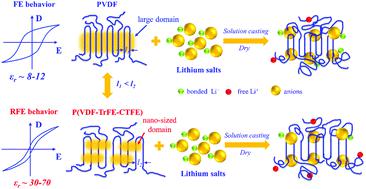当前位置:
X-MOL 学术
›
Energy Environ. Sci.
›
论文详情
Our official English website, www.x-mol.net, welcomes your feedback! (Note: you will need to create a separate account there.)
A relaxor ferroelectric polymer with an ultrahigh dielectric constant largely promotes the dissociation of lithium salts to achieve high ionic conductivity
Energy & Environmental Science ( IF 32.5 ) Pub Date : 2021-10-04 , DOI: 10.1039/d1ee02663a Yan-Fei Huang 1, 2 , Tian Gu 1, 3 , Guanchun Rui 4 , Peiran Shi 1, 3 , Wenbo Fu 5 , Lai Chen 6 , Xiaotong Liu 1, 3 , Jianping Zeng 2 , Benhao Kang 2 , Zhichao Yan 2 , Florian J. Stadler 2 , Lei Zhu 3 , Feiyu Kang 1, 3 , Yan-Bing He 1
Energy & Environmental Science ( IF 32.5 ) Pub Date : 2021-10-04 , DOI: 10.1039/d1ee02663a Yan-Fei Huang 1, 2 , Tian Gu 1, 3 , Guanchun Rui 4 , Peiran Shi 1, 3 , Wenbo Fu 5 , Lai Chen 6 , Xiaotong Liu 1, 3 , Jianping Zeng 2 , Benhao Kang 2 , Zhichao Yan 2 , Florian J. Stadler 2 , Lei Zhu 3 , Feiyu Kang 1, 3 , Yan-Bing He 1
Affiliation

|
The extremely low room-temperature ionic conductivity of solid-state polymer electrolytes (SPEs) ranging from 10−7 to 10−5 S cm−1 seriously restricts their practical application in solid-state lithium metal batteries (LMBs). Herein, a unique relaxor ferroelectric (RFE) polymer of poly(vinylidene fluoride-co-trifluoroethylene-co-chlorotrifluoroethylene) [P(VDF-TrFE-CTFE)] is first investigated as a matrix of SPEs. We find that the P(VDF-TrFE-CTFE) with an ultrahigh dielectric constant (εr) of 44 presents a stronger solvation ability towards lithium ions, which promotes the dissociation of LiN(SO2CF3)2 to form more free charge carriers and enhances their mobility compared to the conventional PVDF with a low εr of 9. The P(VDF-TrFE-CTFE) based SPEs show a much higher ionic conductivity of 3.10 × 10−4 S cm−1 at 25 °C and lower activation energy (0.26 eV) than PVDF based SPEs (1.77 × 10−5 S cm−1 and 0.49 eV). The PVDF blended with the P(VDF-TrFE-CTFE) or dielectric fillers such as BaTiO3 further confirm that the hybrid electrolytes with a larger εr show a higher ionic conductivity. In addition, very tight interfaces of P(VDF-TrFE-CTFE) based SPEs with both the cathode and Li metal anode are constructed to ensure a stable interfacial resistance during cycling. The LiFePO4/Li and LiNi0.8Co0.1Mo0.1O2/Li batteries using P(VDF-TrFE-CTFE) based SPEs present a stable cycling performance at 25 °C. This work proposes a new strategy and opens a new research area to construct SPEs with high ionic conductivity by greatly increasing the εr of polymers.
中文翻译:

具有超高介电常数的弛豫铁电聚合物极大地促进了锂盐的解离以实现高离子电导率
从10 -7到10 -5 S cm -1的固态聚合物电解质(SPE)的极低室温离子电导率严重限制了它们在固态锂金属电池(LMB)中的实际应用。在此,聚独特弛豫铁电(RFE)聚合物(偏二氟共-trifluoroethylene-共-chlorotrifluoroethylene)[P(VDF-TrFE的-CTFE)]首先调查作为对SPE的矩阵。我们发现具有 44的超高介电常数 ( ε r )的 P(VDF-TrFE-CTFE)对锂离子具有更强的溶剂化能力,从而促进了 LiN(SO 2 CF 3 ) 2的解离与传统的 PVDF 相比,ε r为 9 ,形成更多的自由载流子并提高其迁移率。基于 P(VDF-TrFE-CTFE) 的 SPE 显示出更高的离子电导率,为 3.10 × 10 -4 S cm -1在 25 °C 和比基于 PVDF 的 SPE(1.77 × 10 -5 S cm -1和 0.49 eV)更低的活化能(0.26 eV)。PVDF 与 P(VDF-TrFE-CTFE) 或介电填料如 BaTiO 3混合进一步证实了具有更大ε r的混合电解质显示出较高的离子电导率。此外,构建了基于 P(VDF-TrFE-CTFE) 的 SPE 与正极和锂金属负极的非常紧密的界面,以确保循环过程中稳定的界面电阻。使用基于 P(VDF-TrFE-CTFE) 的 SPE的 LiFePO 4 /Li 和 LiNi 0.8 Co 0.1 Mo 0.1 O 2 /Li 电池在 25 °C 下表现出稳定的循环性能。这项工作提出了一种新策略并开辟了一个新的研究领域,通过大大增加聚合物的ε r来构建具有高离子电导率的 SPE 。
更新日期:2021-10-20
中文翻译:

具有超高介电常数的弛豫铁电聚合物极大地促进了锂盐的解离以实现高离子电导率
从10 -7到10 -5 S cm -1的固态聚合物电解质(SPE)的极低室温离子电导率严重限制了它们在固态锂金属电池(LMB)中的实际应用。在此,聚独特弛豫铁电(RFE)聚合物(偏二氟共-trifluoroethylene-共-chlorotrifluoroethylene)[P(VDF-TrFE的-CTFE)]首先调查作为对SPE的矩阵。我们发现具有 44的超高介电常数 ( ε r )的 P(VDF-TrFE-CTFE)对锂离子具有更强的溶剂化能力,从而促进了 LiN(SO 2 CF 3 ) 2的解离与传统的 PVDF 相比,ε r为 9 ,形成更多的自由载流子并提高其迁移率。基于 P(VDF-TrFE-CTFE) 的 SPE 显示出更高的离子电导率,为 3.10 × 10 -4 S cm -1在 25 °C 和比基于 PVDF 的 SPE(1.77 × 10 -5 S cm -1和 0.49 eV)更低的活化能(0.26 eV)。PVDF 与 P(VDF-TrFE-CTFE) 或介电填料如 BaTiO 3混合进一步证实了具有更大ε r的混合电解质显示出较高的离子电导率。此外,构建了基于 P(VDF-TrFE-CTFE) 的 SPE 与正极和锂金属负极的非常紧密的界面,以确保循环过程中稳定的界面电阻。使用基于 P(VDF-TrFE-CTFE) 的 SPE的 LiFePO 4 /Li 和 LiNi 0.8 Co 0.1 Mo 0.1 O 2 /Li 电池在 25 °C 下表现出稳定的循环性能。这项工作提出了一种新策略并开辟了一个新的研究领域,通过大大增加聚合物的ε r来构建具有高离子电导率的 SPE 。



























 京公网安备 11010802027423号
京公网安备 11010802027423号